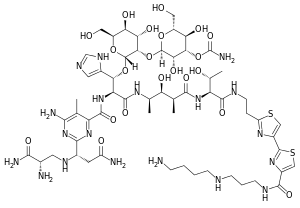Pingyangmycin
Pingyangmycin (also known as bleomycin A5) is an antitumor glycopeptide antibiotic belonging to the bleomycin family, which is produced by Streptomyces verticillus var. pingyangensis n.sp., a variety of Streptomyces verticillus. It was discovered in 1969 at Pingyang County of Zhejiang Province in China, and was brought into clinical use in 1978.[1]
 | |
| Clinical data | |
|---|---|
| Other names | Bleomycin A5 |
| Pregnancy category |
|
| Routes of administration | intravenous, intra-arterial, intramuscular, intratumoral |
| Legal status | |
| Legal status |
|
| Pharmacokinetic data | |
| Metabolism | amidase |
| Elimination half-life | 1.3 hours |
| Excretion | renal (25-50%) |
| Identifiers | |
| |
| CAS Number |
|
| PubChem CID | |
| ChemSpider | |
| UNII | |
| ECHA InfoCard | 100.031.221 |
| Chemical and physical data | |
| Formula | C57H89N19O21S2 |
| Molar mass | 1440.56126 g·mol−1 |
| 3D model (JSmol) | |
| |
| |
In China, pingyangmycin has largely superseded bleomycin A2 (commonly known as "bleomycin"), since it is more effective, costs less, is easier to get, can treat a larger variety of cancers (such as breast cancer and liver cancer) and causes less lung injury.[2][3] Though it also results in pulmonary fibrosis, unlike bleomycin, its most serious side effect is anaphylactic shock, which is rare, but may happen even in a low dose, and can be fatal.[4] In addition, it causes a higher incidence of fever than bleomycin; the occurrence of this complication in patients is between 20 and 50%.
References
- Lin FT, Li DD, Yang XP, Li Q, Xue YC, Zhen YS (1979). "[Antitumor activity and preclinical pharmacologic evaluation of pingyangmycin (author's transl)]". Zhonghua Zhong Liu Za Zhi [Chinese Journal of Oncology]. 1 (3): 161–6. PMID 95444.
- Zheng JW, Yang XJ, Wang YA, He Y, Ye WM, Zhang ZY (October 2009). "Intralesional injection of Pingyangmycin for vascular malformations in oral and maxillofacial regions: an evaluation of 297 consecutive patients". Oral Oncology. 45 (10): 872–6. doi:10.1016/j.oraloncology.2009.02.011. PMID 19628423.
- Xu HZ, Zhang HY (October 1980). "[The isolation and identification of pingyangmycin (author's transl)]". Yao Xue Xue Bao = Acta Pharmaceutica Sinica. 15 (10): 609–14. PMID 6167140.
- Shou BQ, Mao Z, Zhang SL, Yang Z (October 2009). "[Allergy caused by minidose and low concentration Pingyangmycin: a case report]". Hua Xi Kou Qiang Yi Xue Za Zhi = Huaxi Kouqiang Yixue Zazhi = West China Journal of Stomatology. 27 (5): 572–3. PMID 19927737.